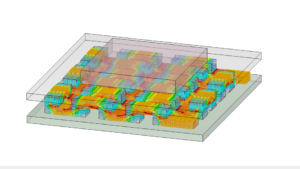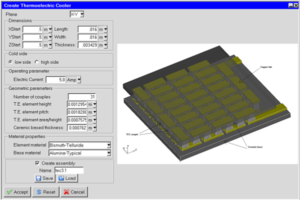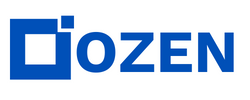
Chris Cowan
ANSYS simulation enables high-resolution modeling of thermoelectric devices. Through this capability users can determine the resulting temperature distribution, power, coefficient of performance, and more when considering thermoelectric effects.
A brief overview of the thermoelectric phenomena that can be simulated:
- Joule heating – Heating occurs in a resistive conductor carrying an electric current. Joule heating is proportional to the square of the current and is independent of the current direction.
- Seebeck effect – A voltage (Seebeck EMF) is produced in a thermoelectric material by a temperature difference. The induced voltage is proportional to the temperature difference. The proportionality coefficient is known as the Seebeck Coefficient (α).
- Peltier effect – Cooling or heating occurs at a junction of two dissimilar thermoelectric materials when an electric current flows through that junction. Peltier heat is proportional to the current, and changes sign if the current direction is reversed.
- Thomson effect – Heat is absorbed or released in a non-uniformly heated thermoelectric material when electric current flows through it. Thomson heat is proportional to the current, and changes sign if the current direction is reversed.
ANSYS users have several software options to solve for thermoelectric cooling or generation using Mechanical, AIM, and IcePak.
A Steady-State Thermal-Electric Conduction analysis in ANSYS Mechanical allows for a simultaneous solution of thermal and electric fields. This coupled-field capability models joule heating for resistive materials and contact electric conductance as well as Seebeck, Peltier, and Thomson effects for thermoelectricity.
ANSYS AIM offers a quick and easy platform for designers to solve multiple physics. AIM features an intuitive graphical user interface and wizard-driven workflow. AIM includes direct current electric conduction analysis, so that current distribution, power loss and voltage drop of product designs can be determined. AIM’s many options for multiphysics simulation include fully coupled thermoelectric–stress analysis, which allows power loss to be used as a heat source to compute temperatures — and subsequent thermal deformation and stress — of product designs.
ANSYS IcePak is a vertical application for fluid-thermal analysis of electronics enclosures. IcePak offers
a custom interface menu to build a thermoelectric module by specifying: orientation, dimensions, current, and materials (from a library).
If you would like to learn more simulating thermoelectric modules in ANSYS, please contact Ozen Engineering staff to discuss.

Current density in a thermoelectric cooler in AIM

Thermoelectric Cooler Interface in IcePak



